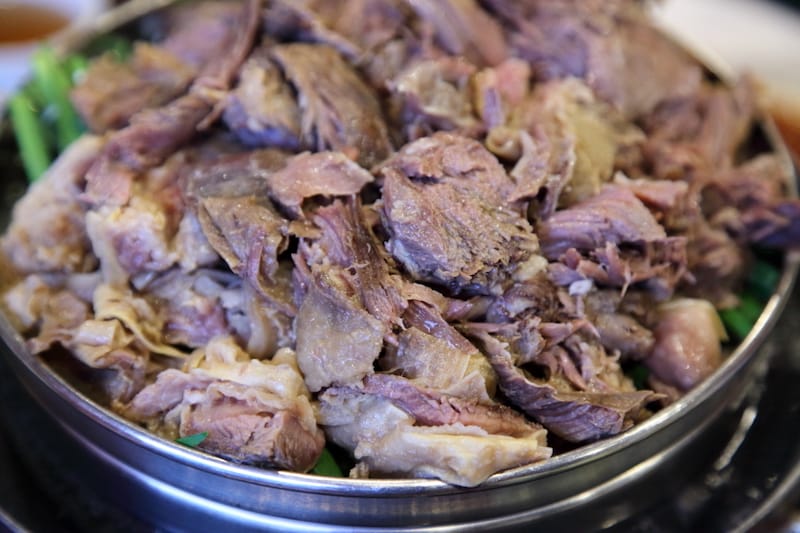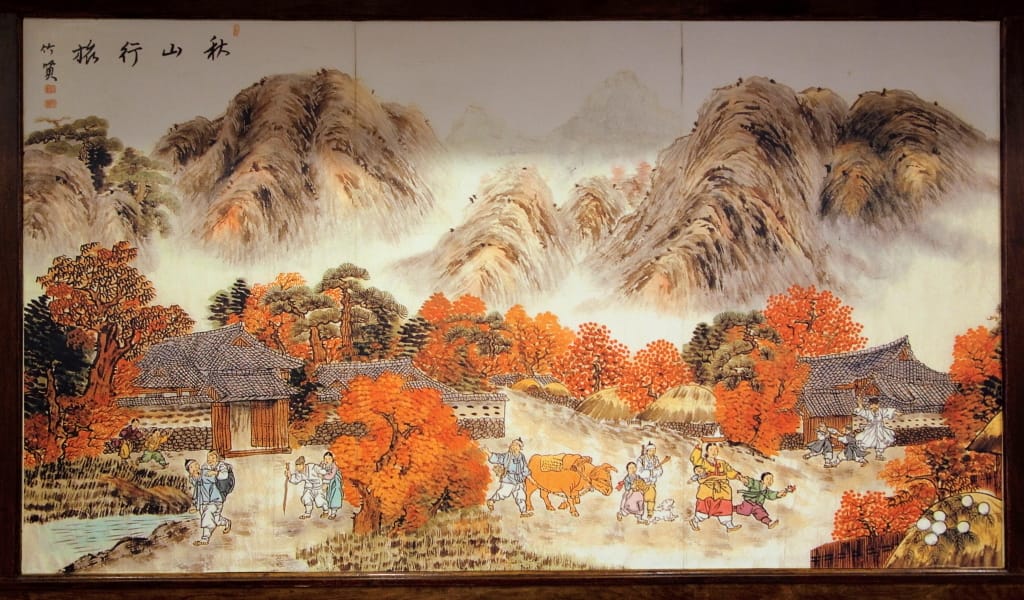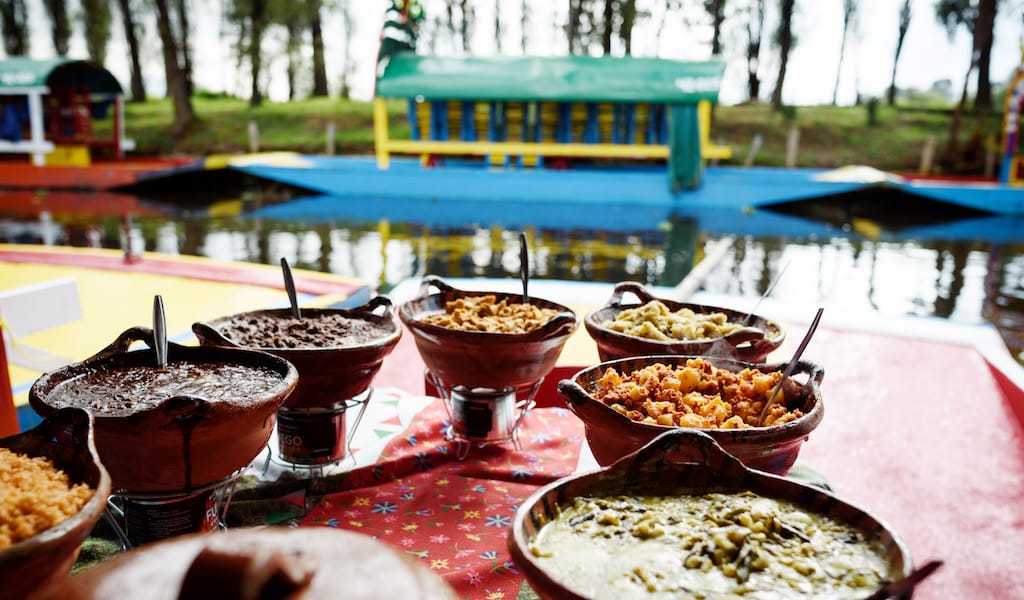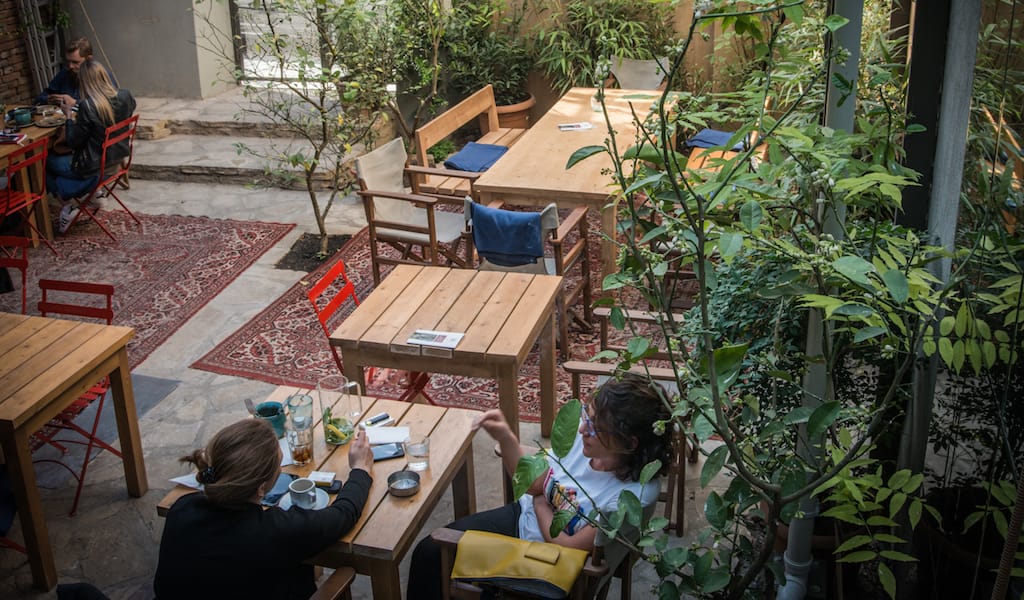Editor’s note: We regret to report that Banggane has closed.
The weather prompted us to order as much as we did. Winter was chilling us to the bone on our first visit, several years ago, to Banggane (Bahn-gah-Nay). This Korean restaurant in Murray Hill sits on a wide-open stretch of Northern Boulevard that’s particularly exposed to the wind. A three-course feast of Korean black goat would set us right, we were sure.
“In winter it warms you,” Chris Kwak, the owner, agrees, when we meet with him on a recent, less frigid afternoon. But at Banggane “summertime is very busy,” too. “When everyone’s already sweating,” he adds, black goat – named for the color of its hair, not its meat – is both refreshing and restorative, or so the traditional thinking goes.
 In Seoul, where Chris was born in the mid-1950s – not long after the armistice that brought a cessation of hostilities to the Korean Peninsula – dishes that feature the native goat have long been consumed as much for medicinal value as for culinary pleasure. Pregnant women eat black goat because it’s “good for the baby, good for the mom,” says Chris. Older people rely on it to regain their strength after surgery; men of a certain age seek it out to improve their vigor. For these purposes, Chris tells us, “we eat black goat only.” No other goat will do.
In Seoul, where Chris was born in the mid-1950s – not long after the armistice that brought a cessation of hostilities to the Korean Peninsula – dishes that feature the native goat have long been consumed as much for medicinal value as for culinary pleasure. Pregnant women eat black goat because it’s “good for the baby, good for the mom,” says Chris. Older people rely on it to regain their strength after surgery; men of a certain age seek it out to improve their vigor. For these purposes, Chris tells us, “we eat black goat only.” No other goat will do.
Even decades after the war, however, not many restaurants in South Korea made a specialty of black goat, Chris tells us. More often it was cooked in home kitchens. This state of affairs may have changed, but Chris hasn’t kept track. In the mid-1990s, he moved to Los Angeles, and seven years later, to New York.
Chris, whose background includes jobs both inside the food industry, as a wholesaler, and outside, as an operator of nail salons, bought Banggane six years ago. (The previous owner retained a similarly named restaurant in New Jersey, under separate management.) Banggane has styled its name in more ways than one – Korea’s Hangul script can be Romanized by using several different systems – but at present the restaurant’s facade displays the name only in Korean, and not in English at all.
The Korean black goat on which Banggane has built its name is raised on a New Jersey farm and procured through the Hunts Point Food Distribution Center, in the Bronx. The goat finds its way into a number of dishes; a solo diner might enjoy the “seasoned black goat meat.” Ours, we recall, was lightly thatched with ginger.
In Seoul, dishes that feature the native goat have long been consumed as much for medicinal value as for culinary pleasure.
For the multicourse goat feast, however, we look to the “boiled black goat meat.” Though the menu indicates that it’s meant for one person, it can and probably should be shared by two or even three, particularly when ordering other dishes. The meat surrounding the ribcage is standard, but Chris informs us that some demanding customers ask instead for goat shoulder or even the very tender meat at the back of the neck. (Presumably these special cuts must be requested in advance; surely they command a higher price.)
Once an order is placed, the banchan arrive, and self-discipline comes into play. Banchan, the assorted small dishes that accompany many Korean meals, aren’t Banggane’s strong suit. Even so, we enjoy a combo of radish and mackerel, a tumbledown heap of sweet black soybeans, and (though perhaps it’s not technically a banchan) a ramekin of sizzling savory golden custard. We taste everything but don’t feel the need to finish them all, let alone ask for replenishments – which is just as well because the goat has arrived.

As we watch, a trayful of goat meat, which has boiled for six hours in the kitchen, is deboned and then placed into a tabletop steamer. In ten minutes, the stage is ours. Into a cupped lettuce leaf we add a tidbit of goat and condiments to our taste: scallion, garlic, chile pepper, fermented soybean paste, spicy bean paste permeated with perilla seeds. We fold the lettuce snugly, take it in whole, savor it slowly and return for more.
After a time, before the steamers are bare, the server transfers the remaining meat to a pot simmering at tableside. Soon she ladles out the second course, a spicy goat-and-vegetable soup that’s hearty enough we might consider it a thin stew. Soon after, the leavings of the soup pot are used to prepare the third course, black goat fried rice.
By this time, tablemates who haven’t paced themselves are leaning back with full bellies, leaving more fried rice – it’s moist yet not oily, and surprisingly complex – for us to enjoy. Healthy appetite, indeed.
 October 17, 2018 Building Blocks
October 17, 2018 Building Blocks
In the early 18th century, before there was the Spinning Jenny, the Cotton Gin and the […] Posted in Naples November 28, 2018 Lunch Aboard a Boat in Xochimilco
November 28, 2018 Lunch Aboard a Boat in Xochimilco
On our special five-day culinary adventure in Mexico City, we eat one of our meals on […] Posted in Mexico City May 14, 2018 Alubali
May 14, 2018 Alubali
Going to dinner at a Georgian restaurant typically means having to fast all day. The […] Posted in Tbilisi
Published on April 05, 2019
Related stories
October 17, 2018
Naples | By Kristin Melia
NaplesIn the early 18th century, before there was the Spinning Jenny, the Cotton Gin and the steam engine, a new machine was making waves in Gragnano, the grain capital of the Kingdom of Two Sicilies. It was the torchio, the pasta extruder. And it would radically and permanently change the diet of Italy. Just beyond…
November 28, 2018
Mexico CityOn our special five-day culinary adventure in Mexico City, we eat one of our meals on board a traditional flat-bottomed boat along Xochimilco’s Aztec-era canals that have been in use for more than 2,000 years and are now a UNESCO World Heritage site. The meal is prepared by locals using products from the chinampas, the area’s…
May 14, 2018
TbilisiGoing to dinner at a Georgian restaurant typically means having to fast all day. The table will bulge with must-orders: tomato and cucumber salad, badrijani (eggplant stuffed with garlic and walnuts), an assortment of cheeses and wild greens, and probably pkhali (vegetable pate with walnuts) too. There will be meat, lots of meat – lamb,…



















































































